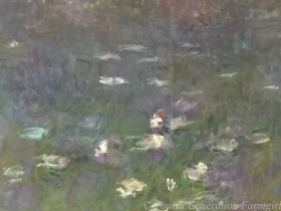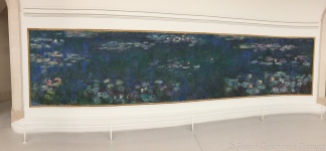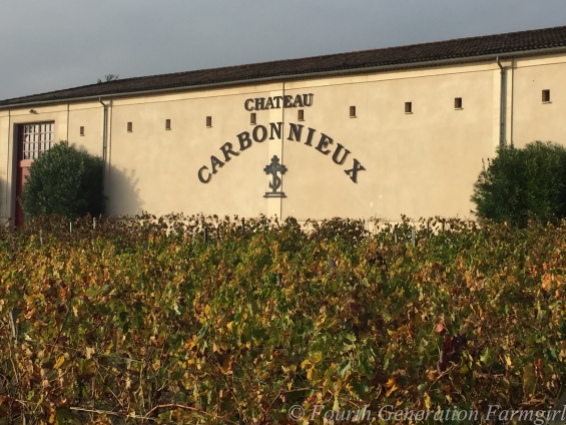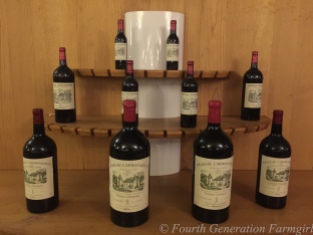Art & The Vine: Monet’s Waterlilies and Chateau Carbonnieux
The water garden at Giverny and Château Carbonnieux
October 2017
The Waterlilies
Musée de l’Orangerie
Paris, France
“Here and there upon the surface, with a strawberry blush, lie the scarlet heart and white edges of a water lily. Further on, many more flowers, but paler, rougher, with a coarser grain, wrinkled and haphazardly scattered in such a graceful tangle that one imagines, as a gallant evening sheds its melancholy veils, frothy roses floating by in unravelled garlands.”
~Marcel Proust, Du côté de chez Swann, Paris, Éditions Gallimard, 1913
The Museum
The Musée de l’Orangerie is an art gallery of impressionist and post-impressionist paintings located in the west corner of the Tuileries Gardens next to the Place de la Concorde (a major public square) in Paris. Originally, an old orangery, this classic and simple work of architecture was built in 1852 to shelter the citrus fruits from the ‘jardin des Tuileries’ in the winter. This stone building is rectangular in shape and constructed in glass on the side of the Seine (to the south) and in bricks on the garden side (to the north) in order to conserve as much heat as possible. Though most famous for being the permanent home for eight Waterlilies murals by Claude Monet, the museum also contains works by Paul Cézanne, Henri Matisse, Amedeo Modigliani, Pablo Picasso, Pierre-Auguste Renoir, Henri Rousseau, and Alfred Sisley, among others.
Eight panels: A Monumental Ensemble
Along two vast elliptic rooms flows a waterscape sprinkled with water-lilies, weeping willow branches, reflections of trees and clouds, “the illusion of a whole without limits, of waters without horizon or banks” in Monet’s own words. A late and long misunderstood example of Impressionism–likened to abstraction because of its monumental size and lack of human presence—this group of mural panels, made up of eight pieces of identical height (200 meters) but different widths, and covering a surface area of approximately 200 square meters sums up the entire life of one artist.
Undertaken over a period of twelve years, from 1914 to 1926, it draws on the familiar environment of Monet: the “water garden” on his property of Giverny, surrounded by trees and decorated with aquatic plants in front of which, for thirty years, the painter set up his easel to delve into its changing rhythms. Without continuum it marks the passing hours of the day from Morning located at the east to Setting Sun at the west. Donated to France by Claude Monet on the day after the signature of the Armistice on November 11, 1918, the Waterlilies or Nymphéas series of decorative panels painted on canvas were installed at the Orangerie according to his plans in 1927, only a few months after his death. The layout of the two rooms show the magnitude of his project: forming a horizontal eight, the symbol of infinity, the very idea Monet sought to represent by painting the microcosm of his water garden at Giverny.
A Monument To Peace
Monet explicitly designed the Waterlilies to be a “refuge”—a place to retire and regenerate, especially for people whose contact with nature had been lost. In 1909, he would describe it as an island amidst the hustle and bustle of modern life where “overworked and strained nerves would be released, in keeping with the restful mood of the sleepy waters, for those who in this place should rest, the room would offer a refuge for peaceful meditation within a flowered aquarium…” The vacant vestibule placed at its entrance is similar to a classical temple, furthering the notion of a serene and near religious experience. The humanist intentions of the Waterlilies were revealed to their fullest when Monet chose to donate them to the French nation—one day after the Armistice. A significant historical gesture and monument to peace: to the military peace that put an end to the First World War and to the peace that lies within the heart of humankind.
Château Carbonnieux and Thomas Jefferson’s Visit in 1787
Jefferson himself said it best: “…so ask the traveled inhabitant of any nation, In what country on earth would you rather live?—certainly in my own, where are all my friends, my relations, and the earliest & sweetest affections and recollections of life.—Which would be your second choice?—France.”
In 1740, the estate was sold to the monks of the Sainte-Croix abbey in Bordeaux and a new era began for Carbonnieux. Initially purchased to be ‘a mother earth’ for the abbey, the Carbonnieux estate soon became the major investment of the Benedictine monks who did not hesitate to borrow huge amounts of money to take their Carbonnieux growth to the very top of white Graves wine ranking. Don Galléas was one of the first to blend varieties and to bottle wine which made it easier for it to be transported and kept for longer before being drunk. His vinification methods and his cellars were among the most modern in the region. In the ranking of the Guyenne Intendance, published in 1776, the white wines of the “Aux Bénédictins de Carbonnieux” were very much appreciated. Although the “premier cru de Pontac” (Haut-Brion) was the reference for red wines at the time, Carbonnieux by far led the ranking of white wines from Guyenne. Thanks to the talents and entrepreneurship of the Benedictine monks from the Sainte-Croix abbey for half a century, the domain flourished and the famous bottle with the Saint Jacques shell attained worldwide renown, from Constantinople to the United States.
In the spring of 1787, Thomas Jefferson, American ambassador to France, future president of the United States, and gastronome and wine lover went on a European tour. He travelled for three months around the south and the west of France and in the north of Italy. His stay in Bordeaux from May 24 to May 28 was a particularly important part of the trip. He visited the most prestigious Châteaux in the Médoc and Graves regions, including Château Carbonnieux which at the time, was owned by Sainte-Croix Benedictine monks. Today, in the Château park stands a pecan tree over 30 meters high and with a circumference of 4.50 meters; an historic monument. Its age, 225 years is said to correspond to Thomas Jefferson’s visit. The Château owners have always referred to this tree as Jefferson’s pecan tree, and it still takes pride of place in the inner courtyard today.
Original text by Professor Bernard Dalisson
Thomas Jefferson Foundation Tour
October 2017
Categories: Art, Photography, Travel, Wine































































Looks fantastic Tonya!
LikeLiked by 1 person
Thank you, Ritu. We loved every minute we were in France, especially Bordeaux! 🙂
LikeLiked by 1 person
So amazingly beautiful!
LikeLiked by 1 person
So glad you enjoyed the post! Thanks, Holly.
LikeLiked by 1 person
so much! Thank you!
LikeLiked by 1 person
🙂
LikeLike
stunning pictures!
LikeLiked by 1 person
Thanks so much, Michele. The panoramic photos were able to capture the panels a little better.
LikeLiked by 1 person
Both experiences are very interesting, Tonya (love Monet, and overall Impressionism is my favorite type of paintings). In the picture, I see all the red wines – does Chateau Carbonnieux still produces white wines?
LikeLiked by 1 person
Yes, they do. Château Carbonnieux continues to produce white as well as red wines. Although they are predominately Sauvignon Blanc, the blend changes from year to year.
Farmguy and I recently enjoyed a 2014 vintage that was 78% Sauvignon Blanc and 22% Semillon. Thanks so much for visiting.
LikeLiked by 1 person
Love, love, love Monet! Lucky girl! 💕
LikeLiked by 1 person
It was fantastic! I hadn’t visited the Waterlilies murals since I studied abroad as a student. It was quite a spiritual experience.
LikeLike
So lovely — all of it!
LikeLiked by 1 person
Thank you! 🙂🌻
LikeLiked by 1 person
You’re welcome, and thank YOU.
LikeLiked by 1 person
Tonya!! You must have been weak-kneed to behold the the art and walk among the estate. I have no words, just thanks for sharing this post and the stunning photos.
LikeLike
Monet and wine is an amazing combination, Tonya! Like a dreamy escape from reality. . . 🌈
LikeLiked by 1 person
I’m delighted you enjoyed the post! Thank you, Robin. 😊💗
LikeLike